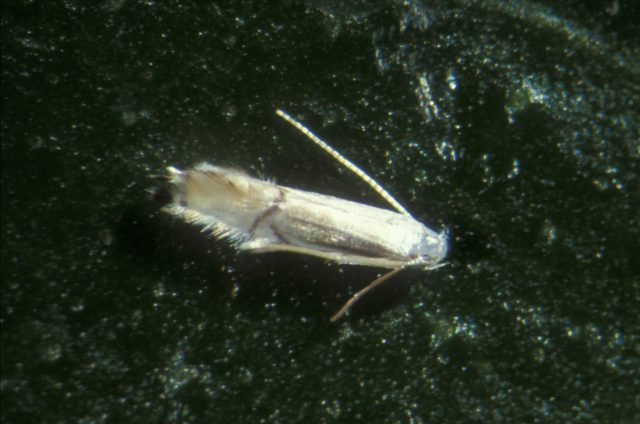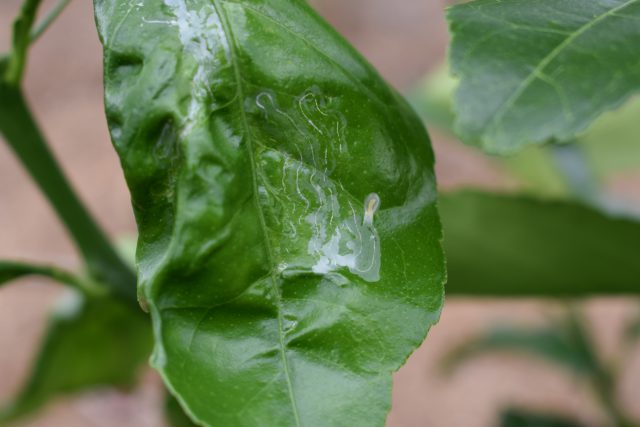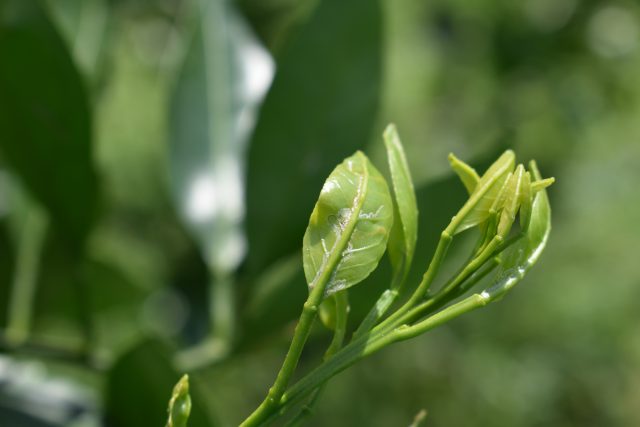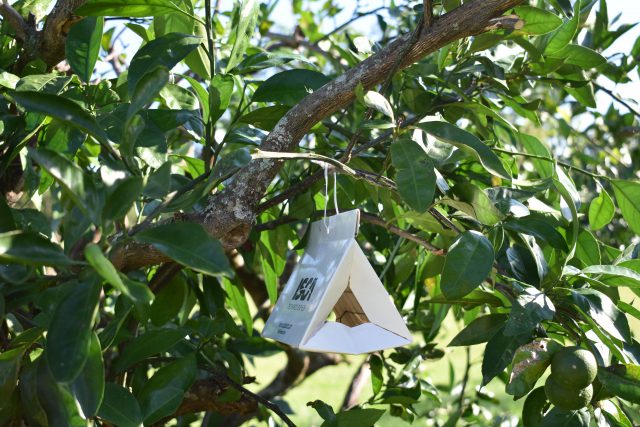Danielle Sprague, Jefferson County Extension and Xavier Martini, UF/IFAS Entomologist, NFREC Quincy
Summer’s in full swing, so citrus groves are actively flushing (growing new leaves). During the flushing period, citrus trees are most susceptible to damage by citrus leafminer, a key insect pest of citrus and related species in the family Rutaceae. The citrus leafminer (CLM) is a small white moth, about 2.4 mm in length. It is more easily detected during the larval stage by the serpentine larval mines (trails of feeding damage) on the underside of new leaves.
The larvae of the citrus leafminer (CLM) feed on the new growth or flush of citrus causing serpentine mines to form under the leaf cuticle. The feeding damage results in leaf curling and distortion. Infestations of CLM on young trees can retard the growth of trees. Another threat concerning CLM in Florida is that the leaf mines provide an opening for citrus canker. Although citrus canker has not been detected in commercial citrus groves in North Florida, an understanding of CLM biology and interaction with citrus flushing cycles is critical for successful management.
Citrus Flush Cycle and CLM
The term “flush” is used in the citrus industry to describe the new foliar growth between bud break and shoot expansion. Citrus trees usually have several flushes per year, depending upon cultivar, climate and crop load. Generally, most citrus cultivars in our area have two major flushes in May and September.
Young citrus trees are most susceptible to damage by CLM, because adults require the new flush for development. Eggs are laid within the flush. After two to ten days, the larvae emerge and feed, causing the mines to occur. Larvae are protected within the leaf and therefore difficult to control. Pupation occurs within the leaf mine and takes anywhere from six to 22 days, depending upon temperature. Adults emerge around dawn and are most active in the morning and evening. In Florida, one generation of CLM is produced about every three weeks, but populations increase when citrus trees are flushing.
Monitoring for CLM
Monitoring for adult CLMs can be useful for determining when moths are flying, and aid in making effective management decisions. The most effective means of monitoring CLM is the use of baited pheromone traps containing a female sex pheromone to attract adult males. Another method used for monitoring adult CLM are sticky traps. Sticky traps should be hung on the outside of the canopy and monitored weekly. One to two traps per acre is recommended for monitoring.
CLM Control
Pheromone Mating Disruption
For organic growers, or growers that wish to reduce the use of insecticides to control CLM, a pheromone based mating disruption product called SPLAT-CLM is commercially available. Pheromone disruption consists of releasing a high quantity of the CLM’s sex pheromone to reduce mating between male and female. A reduction in mating results in a reduction of fertilized eggs and resultant damaging larvae.
Biological Control
In Florida, several natural enemies assist with reducing CLM populations. Studies have shown that predation from natural enemies can reduce CLM populations by 90%. Primary predators of CLM include ants, lacewings and spiders. A parasitic wasp, Ageniaspis citricola was introduced into Florida and has become established. The parasitic wasp attacks the immature stages of CLM. Ageniaspis citricola can be requested and obtained for free from the Florida Department of Agriculture and Consumer Services (FDACS). Because it is a specialized parasitoid of the CLM larval stage, it should be released only when mines start to become visible during a flush.
Insecticides and Timing of Application
Nonbearing trees (<4 years old)
For young citrus trees, the most effective means of preventing leafminer damage is the use of soil-drench insecticide applications. Soil-drench applications have limited effect on natural enemies and provide the longest lasting control of CLM. Currently, there are three 4A Mode of Action (MOA) neonicotinoid insecticides (clothianidin, imidacloprid, thiamethoxam) and one group 28 MOA insecticide (cyantraniliprole) labeled for soil applications (Table 1.). It is important to note that all the neonicotinoids share the same MOA, so repeated exposure to the same MOA can result in the development of insecticide resistance.
Soil applications should be made two weeks prior to flushing to allow time for the insecticide to move from the roots into the canopy. To avoid leaching of insecticide away from the root zone, time soil applications to avoid rain events within a 24 hour period.
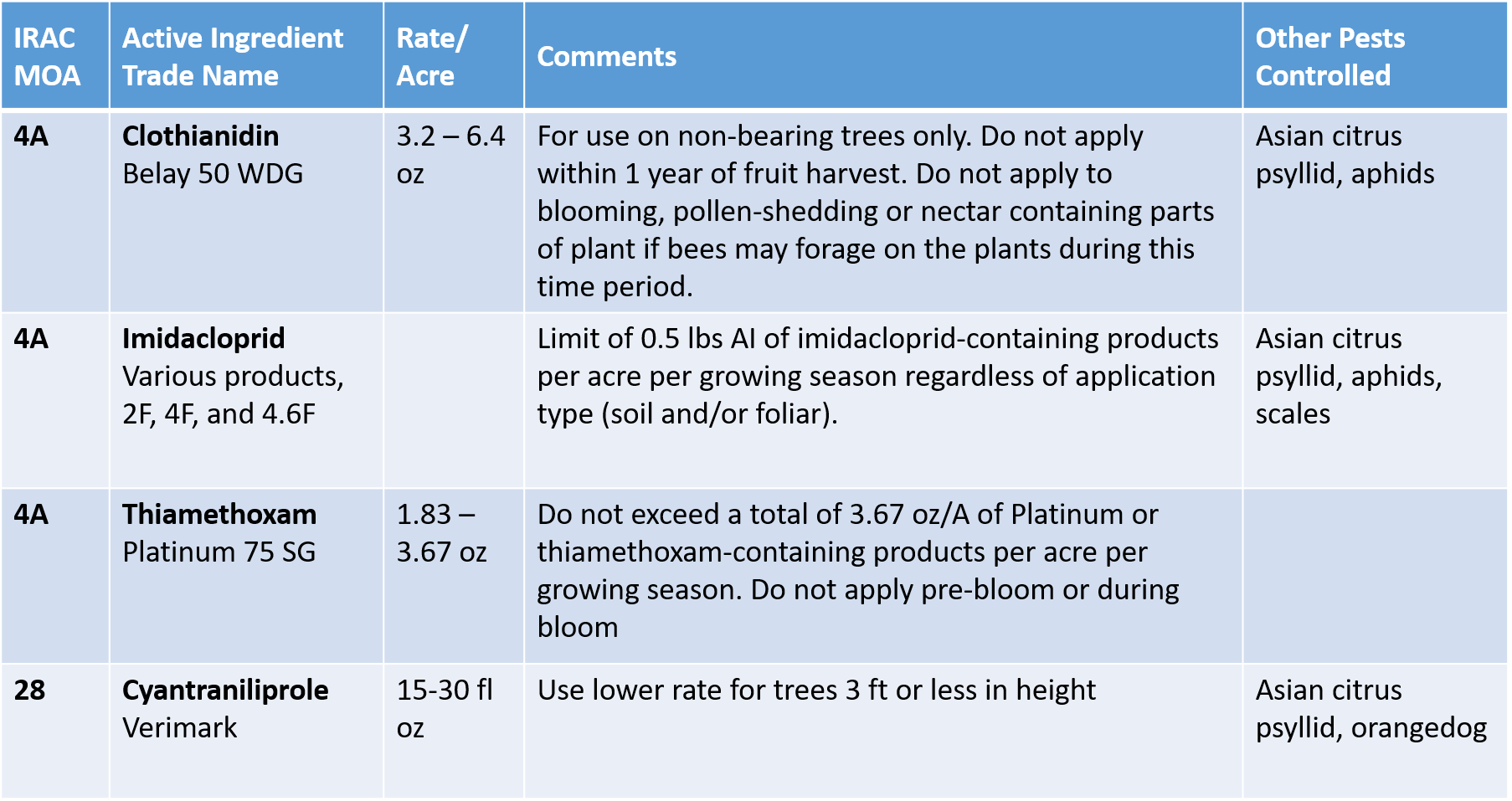
Table 1. Source: 2017-2018 FLORIDA CITRUS PRODUCTION GUIDE
Foliar applications of insecticides provide a shorter duration of protection from CLM, so timing is critical for optimal control. Foliar sprays directed at CLM should be applied when the flush is about halfway expanded to kill the maximum number of CLM. It is not recommended to spray neonicotinoids, if a soil application has been already made.
Mature Bearing trees
Soil applications of neonicotinoids are not effective on mature citrus trees, so the only products labeled for use on mature trees are foliar sprays (Table 2.). Achieving leafminer control with foliar applications on mature trees can be difficult due to unsynchronized flushing of trees. Foliar applications should be timed with the appearance of the first visible leaf mines. Be sure to READ THE LABEL and follow all of the label directions.
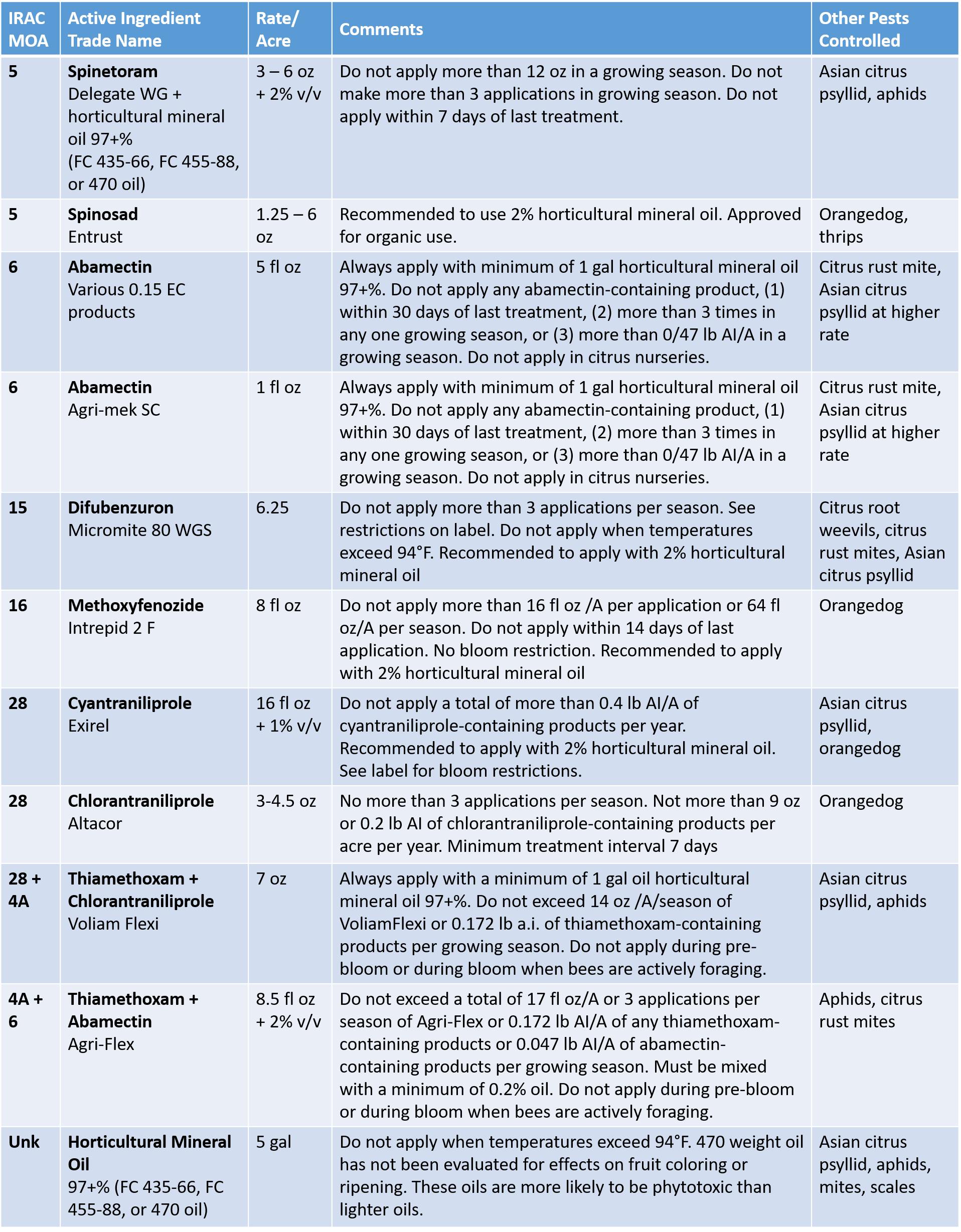
Table 2. Source: 2017-2018 FLORIDA CITRUS PRODUCTION GUIDE
For more information on this topic, use the links to the following publications:
2017-2018 Florida Citrus Production Guide: Citrus Leafminer
UF/IFAS – Citrus Leafminer
2017-2018 Florida Citrus Production Guide
- 2024 Update on Cold Hardy Citrus - April 26, 2024
- Gadsden Tomato Forum – December 7 - October 27, 2023
- Friendly Citrus Fungus: More than Meets the Eye! - September 29, 2023

